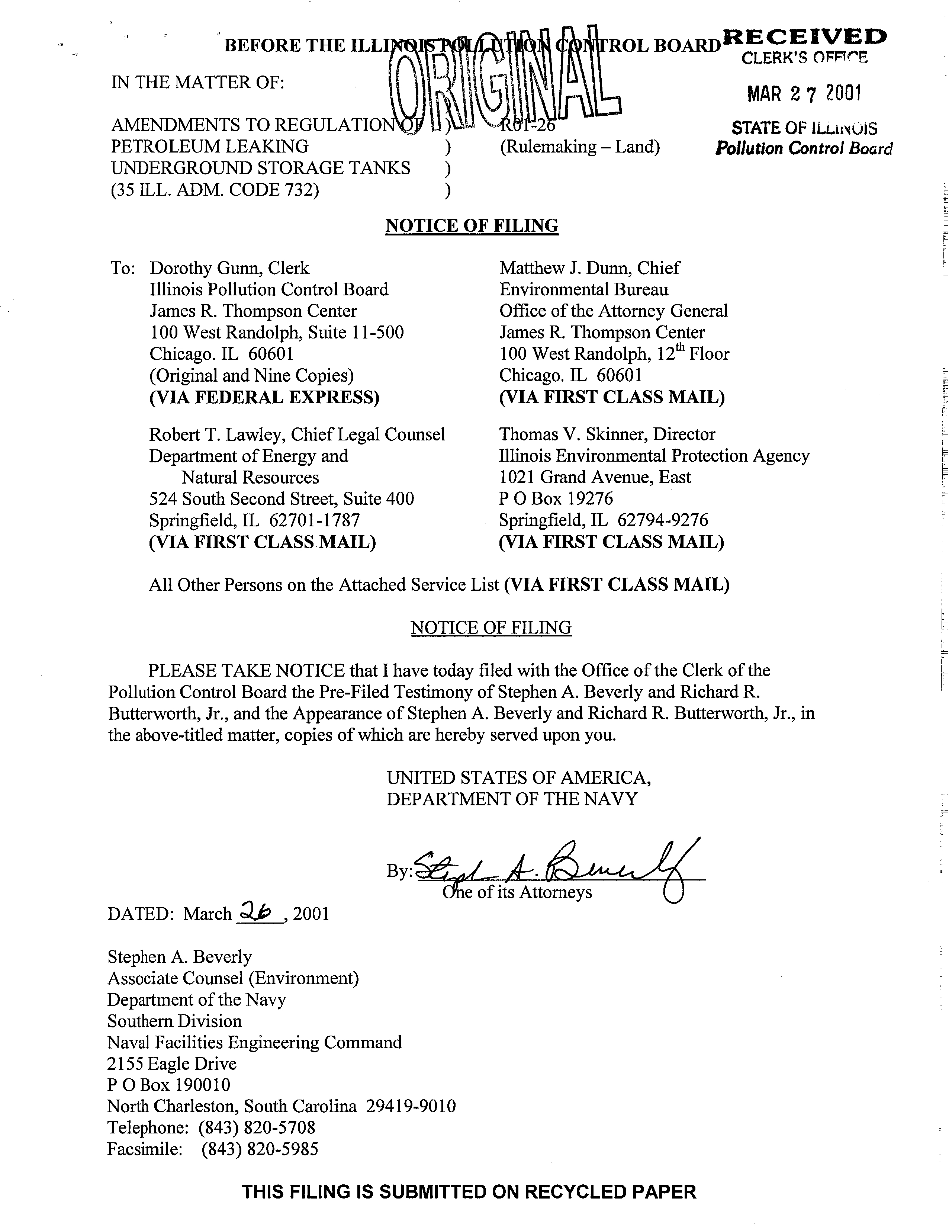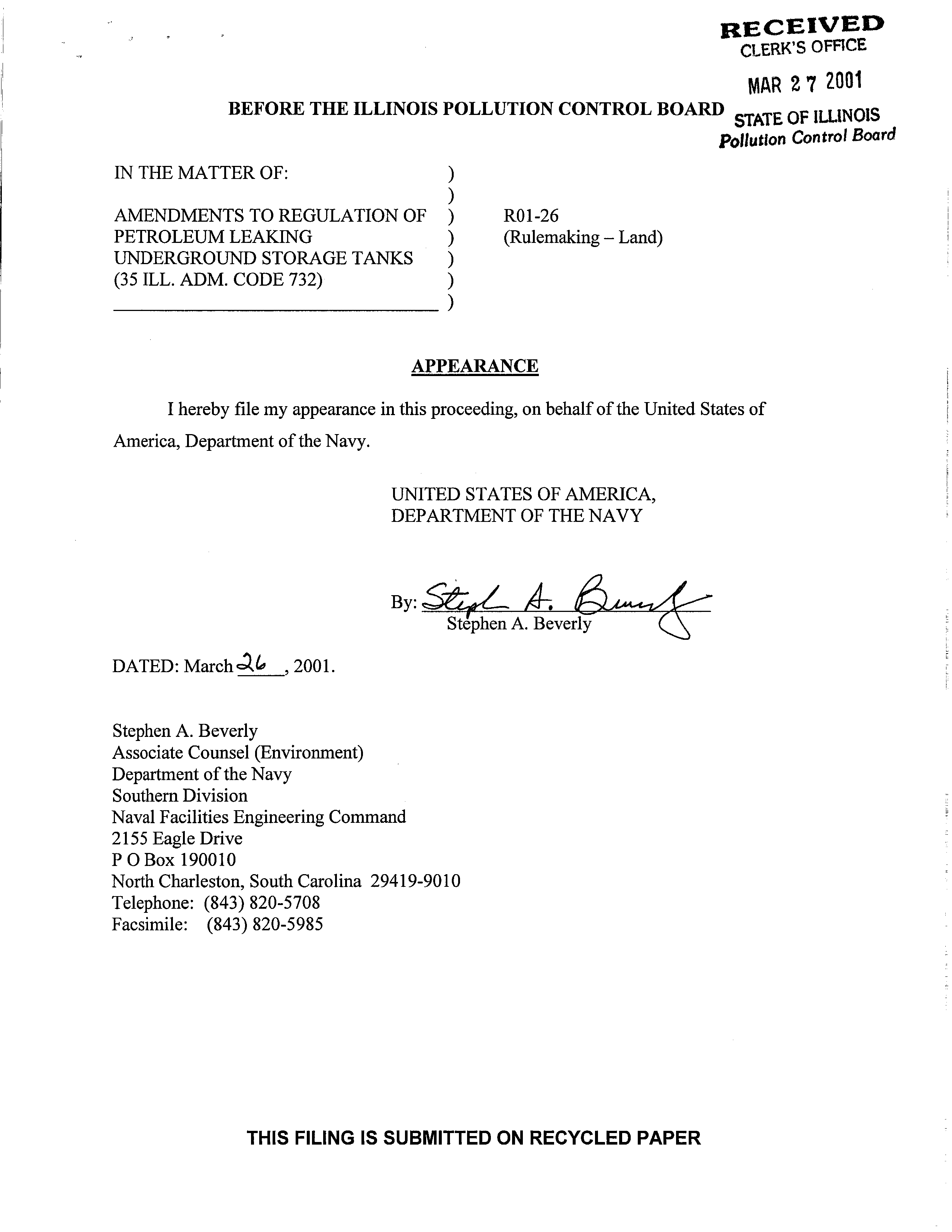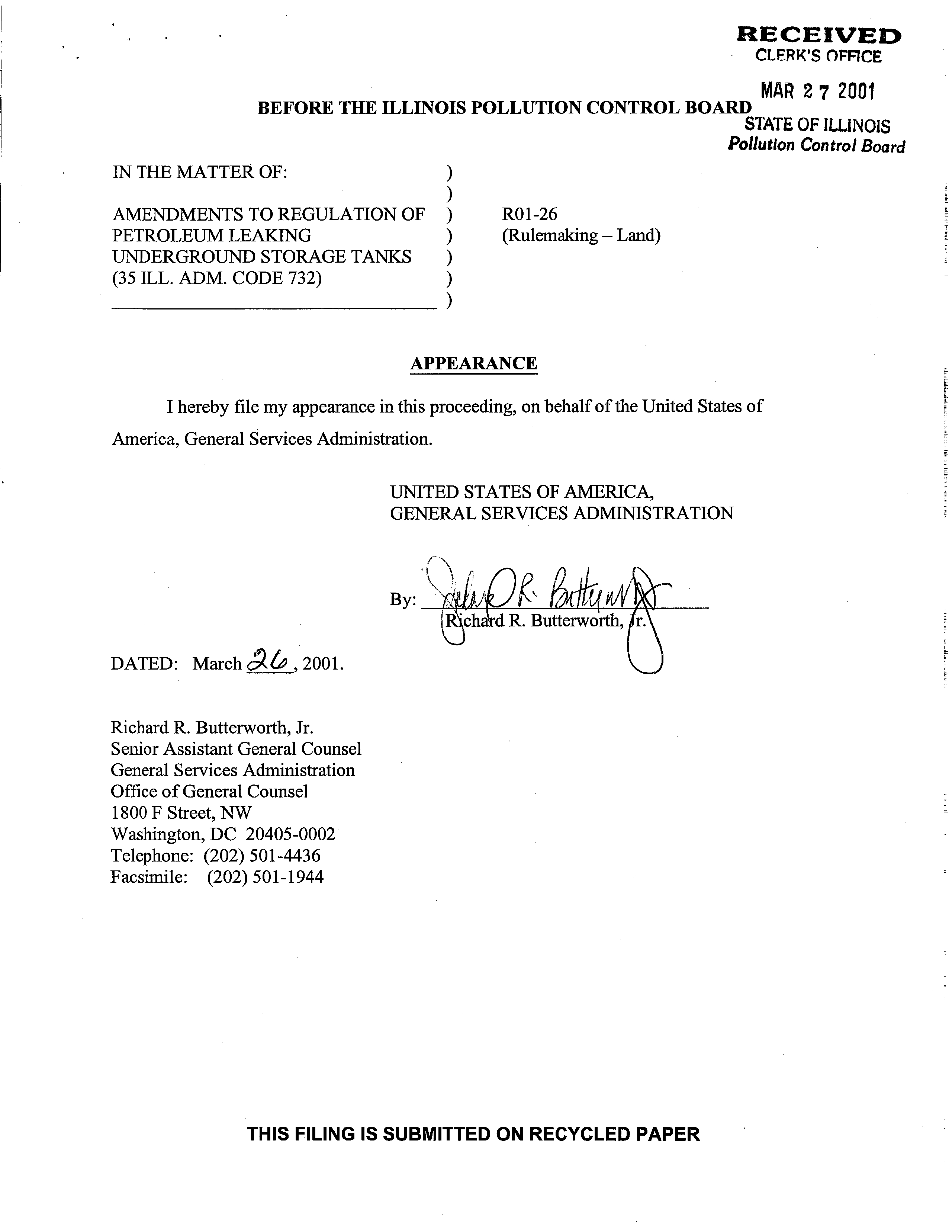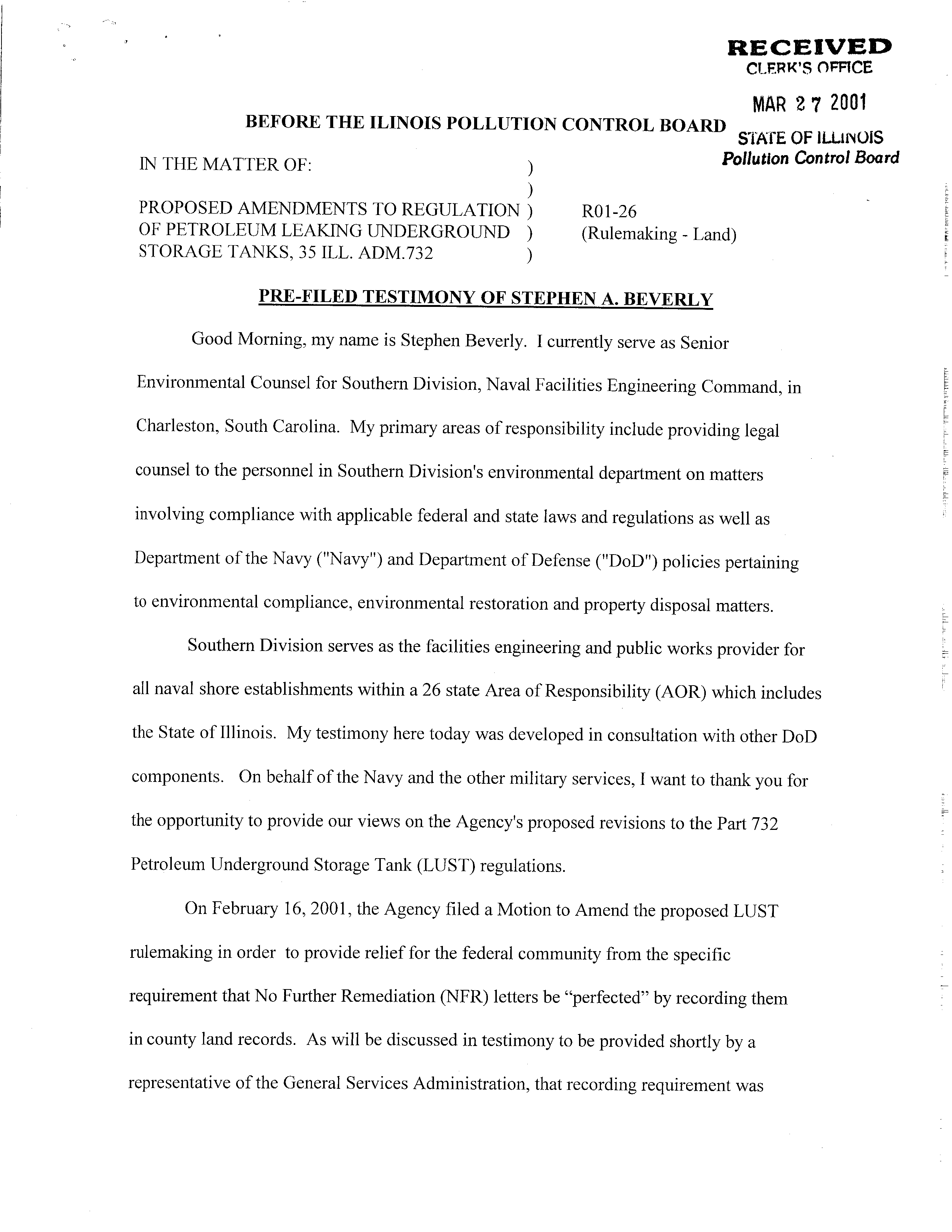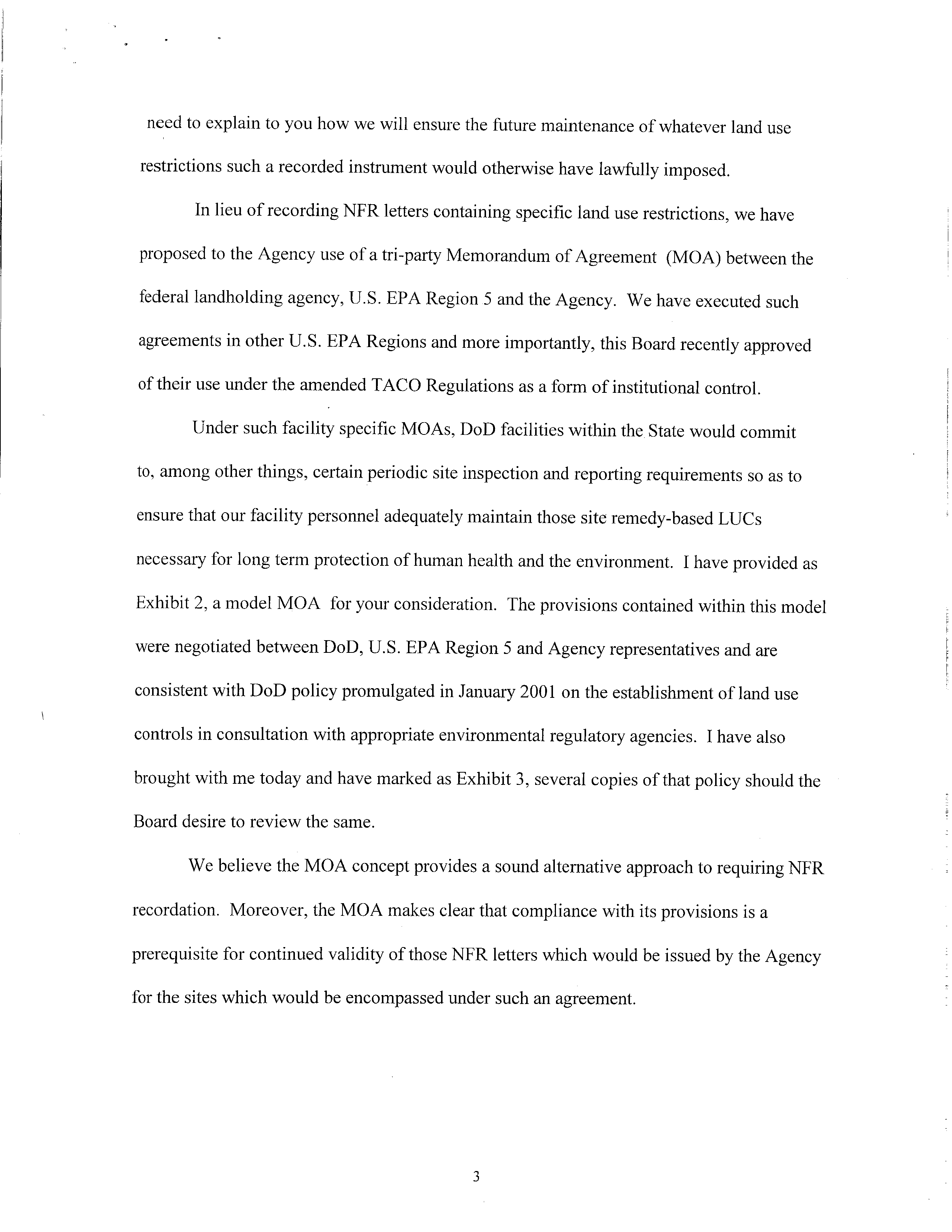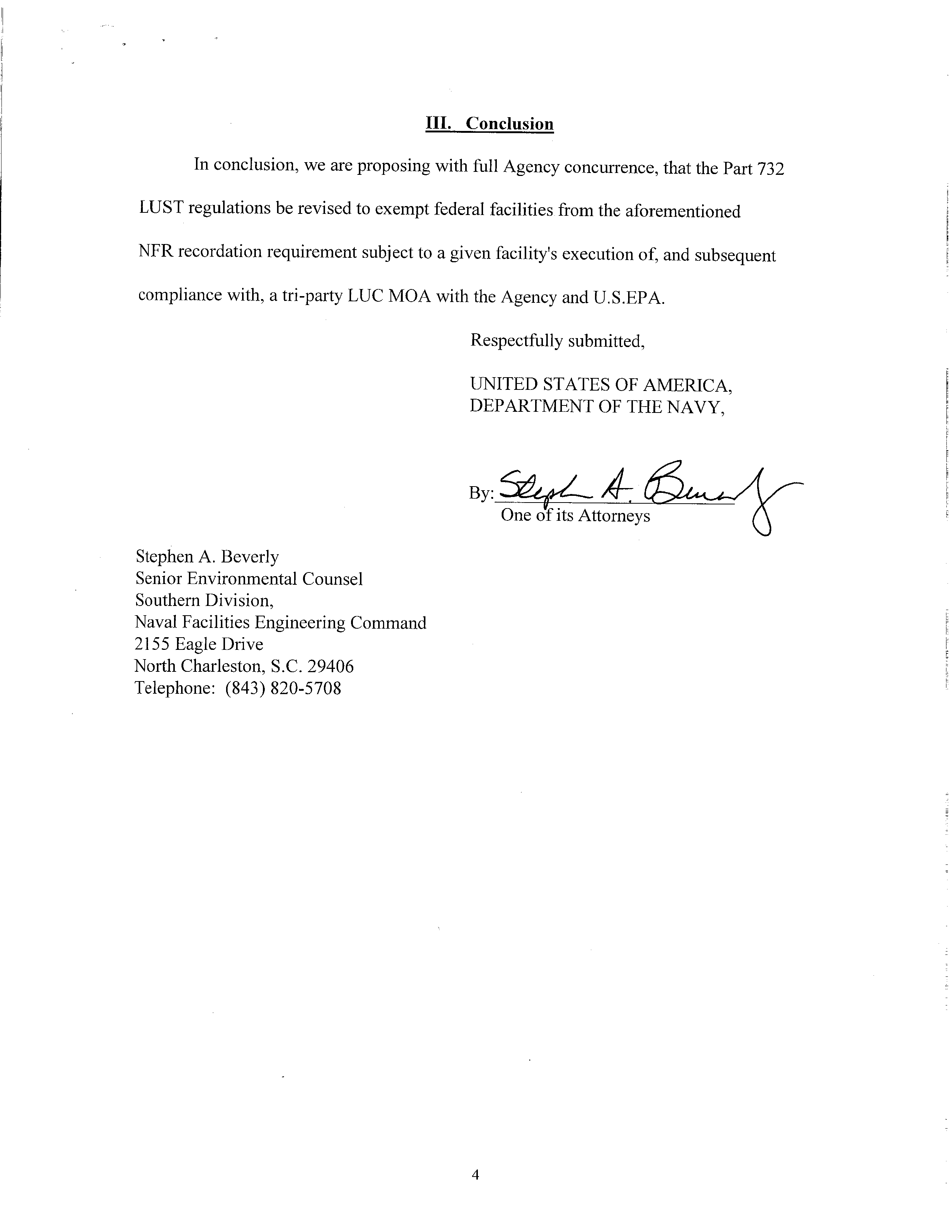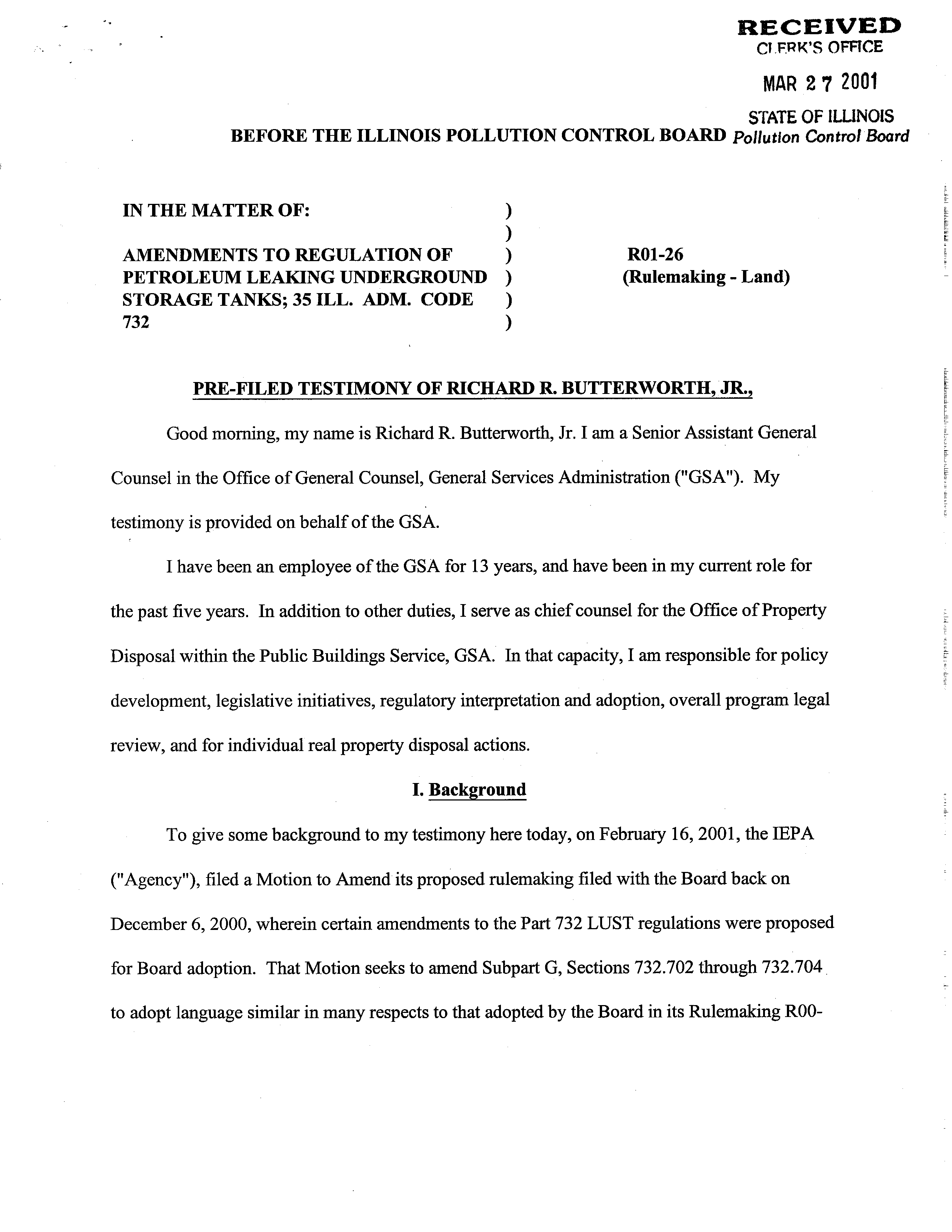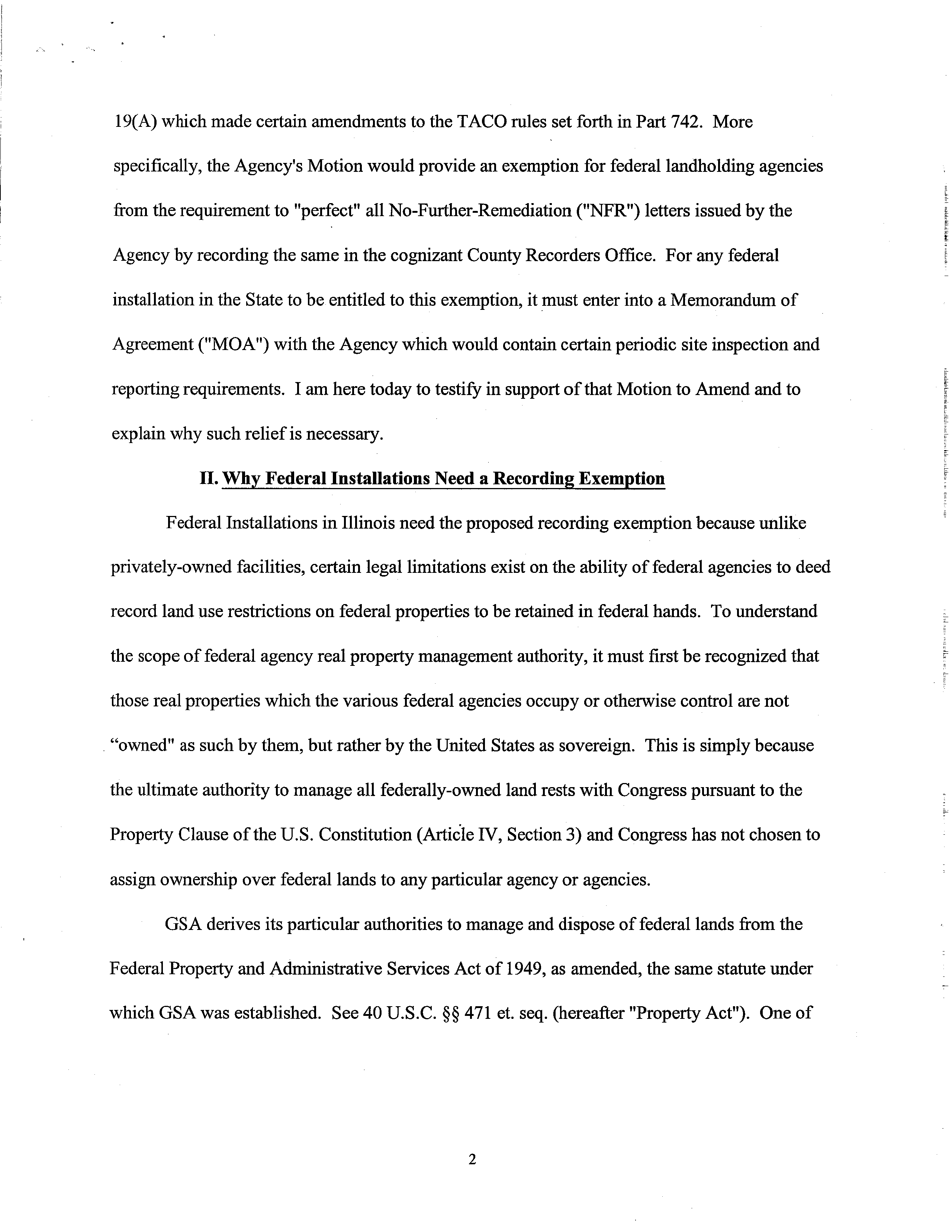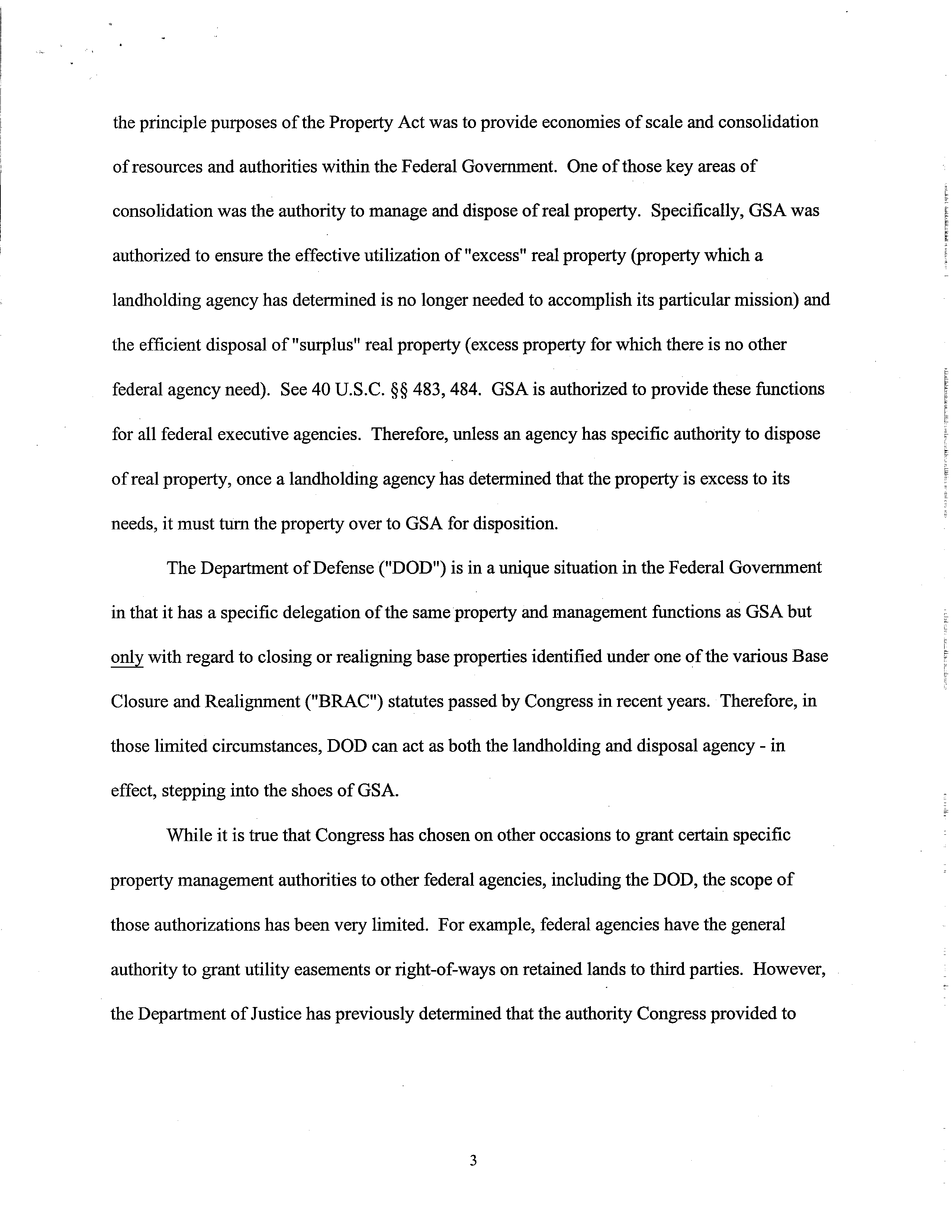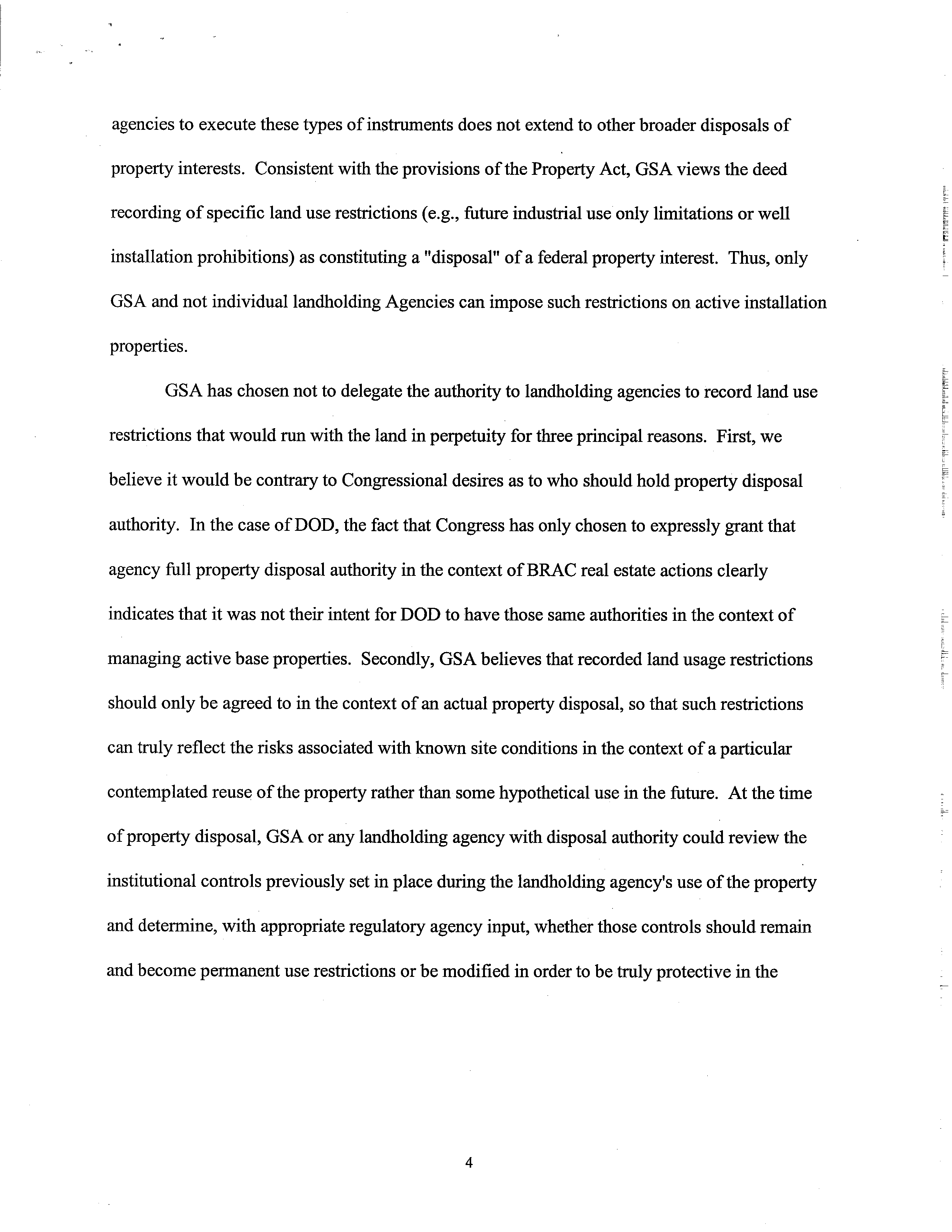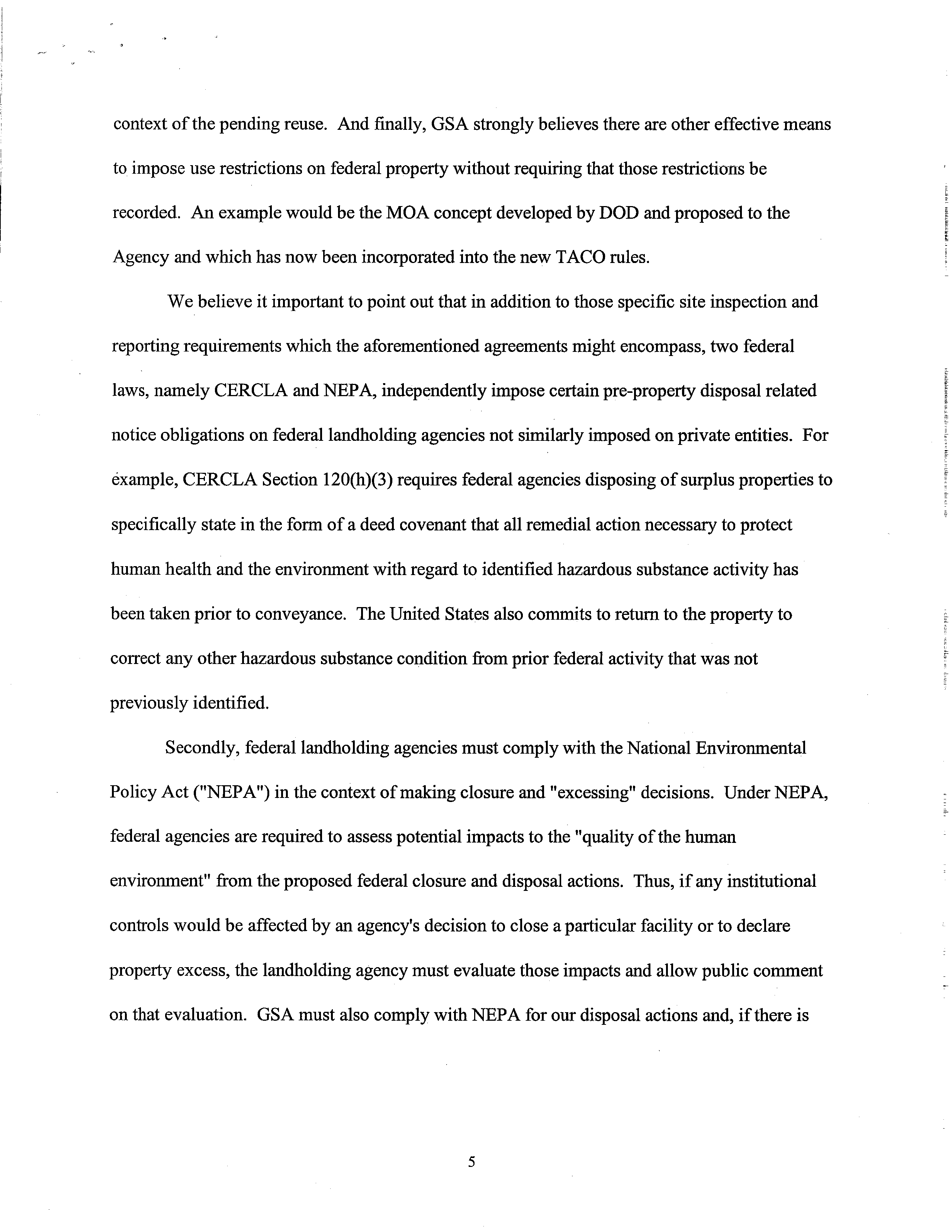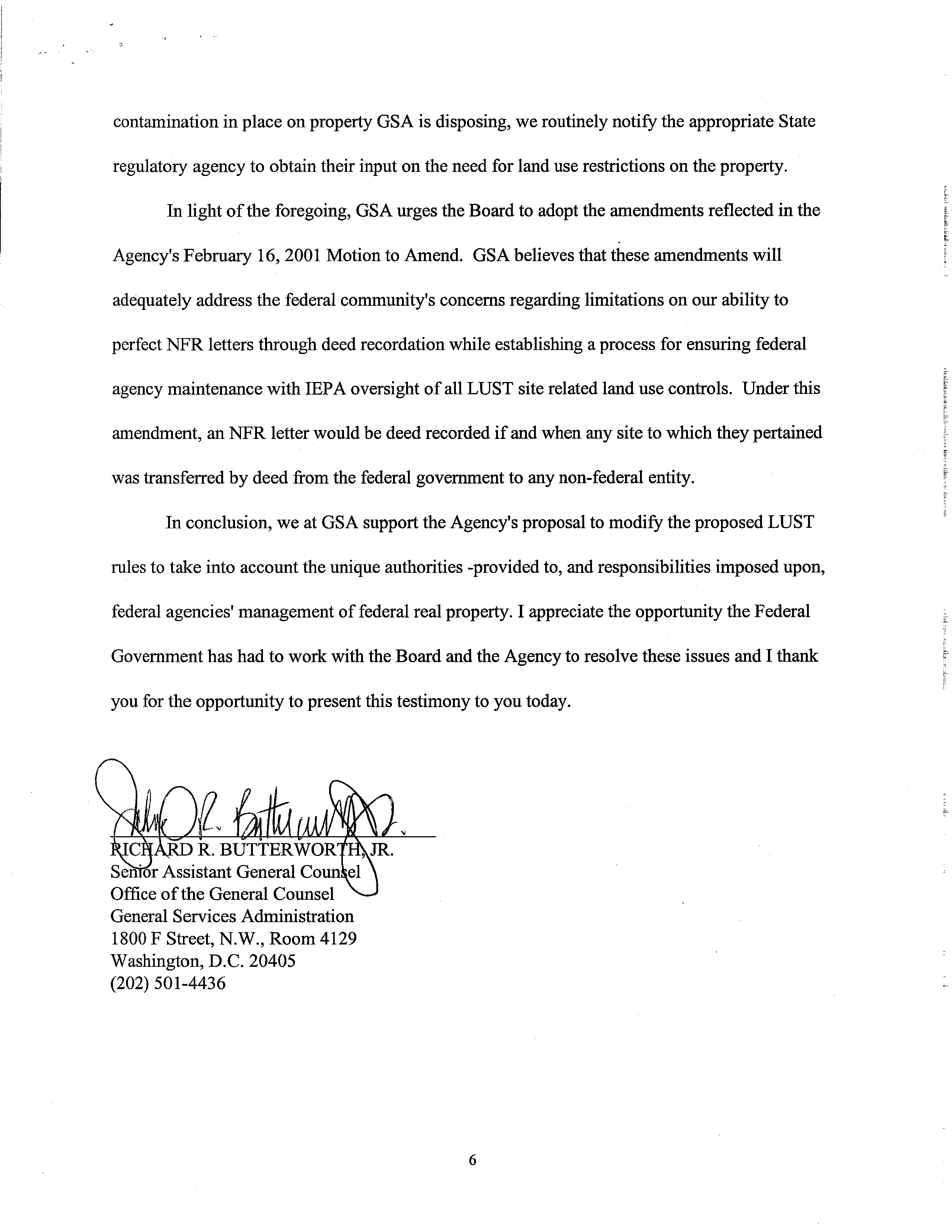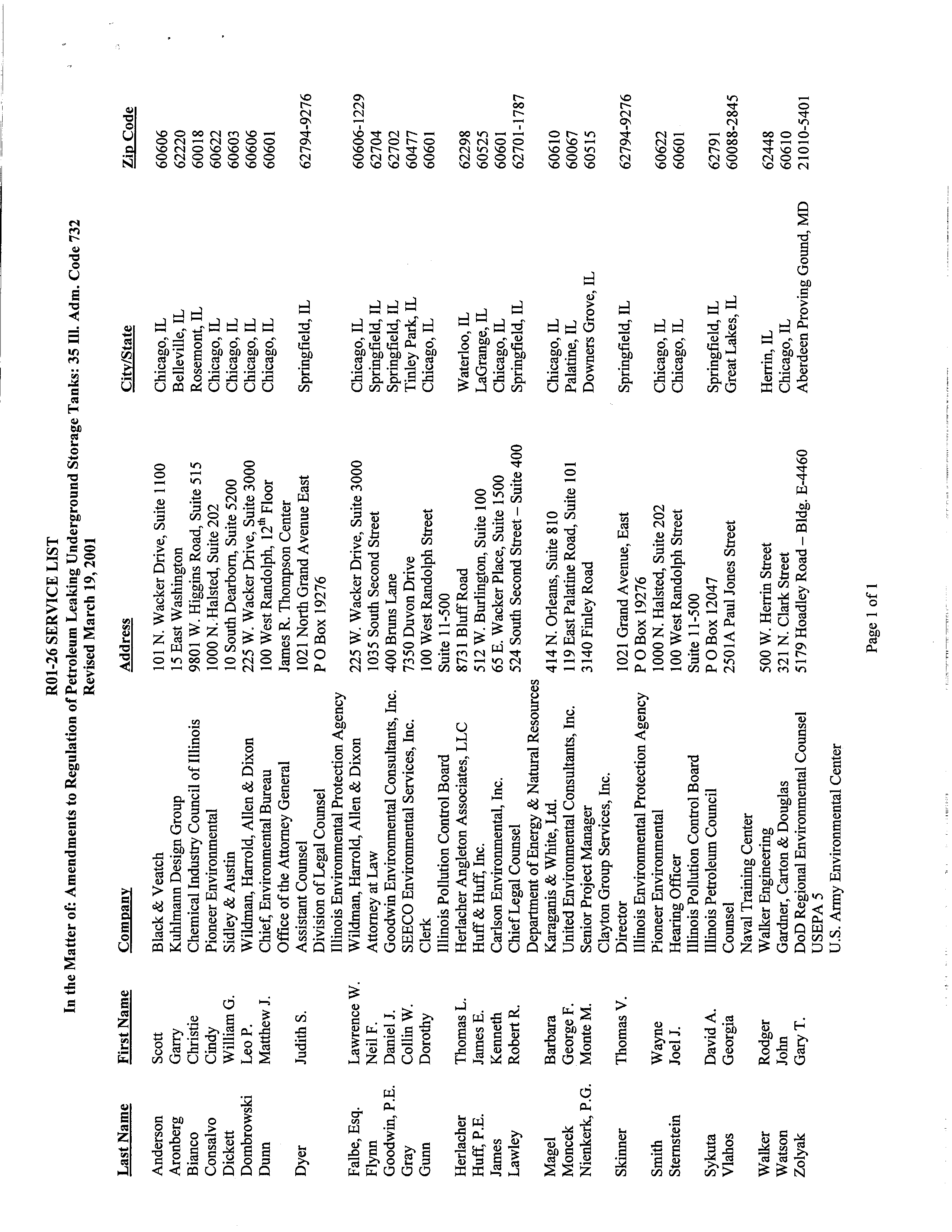BEFORE THE
IN THE MATTER OF:
AMENDMENTS TO REGULATI4
PETROLEUM LEAKING
UNDERGROUND STORAGE TANKS
(35
ILL. ADM. CODE 732)
(Rulemaking
—
Land)
IL BOARDRECEIVED
CLERK’S OFPV~!
MAR27 2001
STATE OF ILu~NuIS
Pollution Control Board
NOTICE OF FILING
To: Dorothy Gunn, Clerk
Illinois Pollution Control Board
James
R. Thompson Center
100 West Randolph, Suite 11-500
Chicago. IL 60601
(Original and Nine Copies)
(VIA FEDERAL
EXPRESS)
Robert T. Lawley, Chief Legal Counsel
Department ofEnergy and
Natural Resources
524
South Second Street, Suite 400
Springfield, IL 62701-1787
(VIA
FIRST CLASS MAIL)
Matthew J. Dunn, Chief
Environmental Bureau
Office ofthe Attorney General
James R. Thompson Center
100 West Randolph,
12th
Floor
Chicago. IL 60601
(VIA FIRST CLASS MAIL)
Thomas V. Skinner, Director
Illinois Environmental Protection Agency
1021 Grand Avenue, East
POBox 19276
Springfield, IL 62794-9276
(VIA FIRST CLASS MAIL)
All Other Persons on the Attached Service List
(VIA FIRST CLASS MAIL)
NOTICE OF FILING
PLEASE TAKE NOTICE that I have today filed with the Office ofthe Clerk ofthe
Pollution Control Board the Pre-Filed Testimony ofStephen A. Beverly and Richard R.
Butterworth, Jr., and the Appearance ofStephen A. Beverly and Richard R. Butterworth, Jr., in
the
above-titled matter, copies ofwhich are hereby served upon you.
UNITED STATES OF AMERICA,
DEPARTMENT
OF THE NAVY
By:
e of its
DATED: March
Qk
,
2001
Stephen A. Beverly
Associate Counsel (Environment)
Department of the Navy
Southern Division
Naval Facilities Engineering Command
2155 Eagle Drive
P 0 Box 190010
North Charleston, South Carolina 29419-9010
Telephone: (843) 820-5708
Facsimile: (843) 820-5985
)
)
)
[7
THIS FILING IS SUBMITTED ON RECYCLED PAPER
RECEIVED
CLERK’S OFFICE
THE ILLINOIS POLLUTION CONTROL
MAR 27 2001
BEFORE
STATE OF ILLINOIS
INTHE MATTER OF:
)
Pollution Control Board
)
AMENDMENTS TO REGULATION OF
)
RO1-26
PETROLEUM LEAKING
)
(Rulemaking
-
Land)
UNDERGROUND
STORAGE TANKS
)
(35 ILL. ADM. CODE 732)
)
______________________________________________________________
)
APPEARANCE
I hereby file my appearance in this proceeding, on behalf ofthe United States of
America, Department ofthe Navy.
UNITED
STATES OF AMERICA,
DEPARTMENT
OF THE NAVY
By:
~ Stephen A
DATED: March
cDL,,
,
2001.
Stephen A. Beverly
Associate Counsel (Environment)
Department ofthe Navy
Southern Division
Naval Facilities Engineering Command
2155 Eagle Drive
POBox
190010
North Charleston, South Carolina
29419-9010
Telephone: (843) 820-5708
Facsimile: (843) 820-5985
THIS FILING IS SUBMITTED ON RECYCLED PAPER
RECEIVED
CLERK’S OFFICE
MAR 2 7 2001
BEFORE THE ILLINOIS POLLUTION CONTROL BOARD
STATE OF ILLINOI5
Pollution Control Board
IN THE MATTER OF:
AMENDMENTS TO REGULATION OF
PETROLEUM LEAKING
UINDERGROUIND STORAGE TANKS
(35
ILL. ADM. CODE 732)
)
)
)
)
)
RO1-26
(Rulemaking
—
Land)
)
)
APPEARANCE
I hereby file my appearance in this proceeding, on behalfofthe United States of
America, General Services Administration.
UNITED STATES OF AMERICA,
GENERAL SERVICES ADMTMSTRATION
,~ N
By:
~cha d R.
<4
Butterworth, r.
DATED: March
____,
2001.
Richard R. Butterworth, Jr.
Senior Assistant General Counsel
General Services Administration
Office of General Counsel
1800 F Street, NW
Washington, DC 20405-0002
Telephone: (202) 501-4436
Facsimile: (202) 501-1944
THIS FILING IS SUBMITTED ON RECYCLED PAPER
RECEIVED
CT FRK’S
OFFICE
MAR 2~7 2001
BEFORE THE ILINOIS POLLUTION CONTROL BOARD
SIAiE QF ILLIINOIS
IN THE MATTER OF:
)
Pollution Control Board
)
PROPOSED AMENDMENTS TO REGULATION)
RO1-26
OF PETROLEUM LEAKING UNDERGROUND
)
(Rulemaking
-
Land)
STORAGE
TANKS,
35
ILL.
ADM.732
)
PRE-FILED TESTIMONY OF STEPHEN
A.
BEVERLY
Good Morning, my name is Stephen Beverly. I currently serve as Senior
Environmental Counsel for Southern Division, Naval Facilities Engineering Command, in
Charleston, South Carolina. My primary areas ofresponsibility include providing legal
counsel to the personnel in Southern Division’s environmental department on matters
involving compliance with applicable federal and state laws and regulations as well as
Department ofthe Navy (‘Navy’) and Department of Defense (“DoD”) policies pertaining
to environmental compliance, environmental restoration and property disposal matters.
Southern Division serves as the facilities engineering and public works provider for
all naval shore establishments within a 26 state Area of Responsibility (AOR) which includes
the State of Illinois. My testimony here today was developed in consultation with other DoD
components. On behalf ofthe Navy and the other military services, I want to thank you for
the opportunity to provide our views on the Agency’s proposed revisions to the Part 732
Petroleum Underground Storage Tank (LUST) regulations.
On February 16, 2001, the Agency filed a Motion to Amend the proposed LUST
rulemaking in order to provide relief for the federal community from the specific
requirement that No Further Remediation (NER) letters be “perfected” by recording them
in county land records. As will be discussed in testimony to be provided shortly by a
representative ofthe General Services Administration, that recording requirement was
problematic for federal landholding entities as we do not generally “own” the federal lands
on which we operate and therefore have no legal authority to record restrictions on their
future use. My focus today is to indicate our support for the Agency’s Motion to Amend with
minor amendments which I have just provided as Exhibit 1. I appreciate this Board’s
willingness to listen to our thoughts in that regard.
I.
Preference for Risk-Based Cleanups
Southern Division’s experience at sites throughout our AOR is that under appropriate
circumstances, risk-based site cleanups can be a protective, timely and cost-effective
alternative
to more extensive and potentially cost prohibitive remedial measures which may,
or may not, ultimately permit unrestricted future land uses. We wish to have
the flexibility afforded by this approach for LUST sites in Illinois where we and the Agency
agree that use ofa risk-based cleanup approach will protect human health and the
environment and is practicable. Unfortunately, unless the changes proposed in the recent
Motion to Amend brought forth by the Agency are adopted, our future ability to do so will be
jeopardized since the existing regulations in Subpart G of Part 732 contain specific deed
recordation requirements which we are legally precluded from satisfying. All that we in the
federal community seek is the same ability which is being afforded those in private industry
to be able to close out our LUST sites with full Agency concurrence utilizing the concept of
risk-based remediation.
II. Why an exception should be made for federal facilities
Because we are asking this Board to adopt an alternative approach to the NER
recordation requirement contained in the existing LUST regulations, we understand that we
2
need to explain to you how we will ensure the future maintenance of whatever land use
restrictions such a recorded instrument would otherwise have lawfully imposed.
In lieu ofrecording NFR letters containing specific land use restrictions, we have
proposed
to the Agency use of a tn-party Memorandum of Agreement (MOA) between the
federal landholding agency, U.S. EPA Region
5
and the Agency. We have executed such
agreements in other U.S. EPA Regions and more importantly, this Board recently approved
of their use under the amended TACO Regulations as a form ofinstitutional control.
Under such facility specific MOAs, DoD facilities within the State would commit
to, among other things, certain periodic site inspection and reporting requirements so as to
ensure that our facility personnel adequately maintain those site remedy-based LUCs
necessary for long term protection of human health and the environment. I have provided as
Exhibit 2, a model MOA for your consideration. The provisions contained within this model
were negotiated between DoD, U.S. EPA Region
5
and Agency representatives and are
consistent with DoD policy promulgated in January 2001 on the establishment of land use
controls in consultation with appropriate environmental regulatory agencies. I have also
brought with me today and have marked as Exhibit 3, several copies ofthat policy should the
Board desire to review the same.
We believe the MOA concept provides a sound alternative approach to requiring NFR
recordation. Moreover, the MOA makes clear that compliance with its provisions is a
prerequisite for continued validity ofthose NFR letters which would be issued by the Agency
for the sites which would be encompassed under such an agreement.
3
III. Conclusion
In conclusion, we are proposing with full Agency concurrence, that the Part 732
LUST regulations be revised to exempt federal facilities from the aforementioned
NER recordation requirement subject to a given facilitys execution of, and subsequent
compliance with, a tn-party LUC MOA with the Agency and U.S.EPA.
Respectfully submitted,
UNITED STATES OF AMERICA,
DEPARTMENT OF THE NAVY,
By:
One of its Attorneys
/4-
Stephen A. Beverly
Senior Environmental Counsel
Southern Division,
Naval Facilities Engineering Command
2155
Eagle Drive
North Charleston, S.C. 29406
Telephone: (843) 820-5708
4
RECEIVED
CT ERK’S OFFTCE
MAR 272001
BEFORE THE ILLINOIS POLLUTION CONTROL BOARD
Pollution
STATE OF
Control
ILLINOIS
Board
IN THE MATTER OF:
)
)
AMENDMENTS TO REGULATION OF
)
RO1-26
PETROLEUM LEAKING UNDERGROUND )
(Rulemaking
-
Land)
STORAGE TANKS; 35 ILL. ADM. CODE
)
732
)
PRE-FILED TESTIMONY OF RICHARD R. BUTTERWORTH, JR.
Good morning, my name is Richard R. Butterworth, Jr. I am a Senior Assistant General
Counsel in the Office ofGeneral Counsel, General Services Administration (“GSA”). My
testimony is provided on behalfofthe GSA.
I have been an employee ofthe GSA for 13 years, and have been in my current role for
the past five years. In addition to other duties, I serve as chiefcounsel for the Office ofProperty
Disposal within the Public Buildings Service, GSA. In that capacity, I am responsible forpolicy
development, legislative initiatives,
regulatory interpretation and adoption, overall program legal
review, and for individual
real property disposal actions.
I. Background
To give some background to my testimony here today, on February 16, 2001, the IEPA
(“Agency”), filed a Motion to Amend its proposed rulemaking filed with the Board back on
December
6, 2000, wherein certain amendments to the Part 732 LUST regulations were proposed
for Board adoption. That Motion seeks to amend Subpart G, Sections 732.702 through 732.704
to adopt
language similar in many respects to that adopted by the Board in its Rulemaking ROO-
19(A) which made certain amendments to the TACO rules set forth in Part 742. More
specifically, the Agency’s Motion would provide an exemption for federal landholding agencies
from the requirementto “perfect” all No-Further-Remediation (“NFR”) letters issued by the
Agency by recording the same in the cognizant County Recorders Office. For any federal
installation in the State to be entitled to this exemption, it must enter into a Memorandum of
Agreement (“MOA”) with the Agency which would contain certain periodic site inspection and
reportingrequirements. I am here today to
testif~i in support ofthat Motion to Amend and to
explain why such reliefis necessary.
II. Why Federal Installations Need a Recording Exemption
Federal Installations in Illinois need the proposed recording exemption because unlike
privately-owned
facilities, certain legal limitations exist on the ability of federal agencies to deed
record land
use restrictions on federal properties to be retained in federal hands. To understand
the
scope of federal agency real property management authority, it must first be recognized that
those real properties which the various federal agencies occupy or otherwise control are not
“owned” as such by them, but rather by the United States as sovereign. This is simply because
the ultimate authority to manage all federally-owned land rests with Congress pursuant to the
Property
Clause ofthe U.S. Constitution (Article IV, Section 3) and Congress has not chosen to
assign ownership over federal lands to any particular agency or agencies.
GSA derives its particular authorities to manage and dispose offederal lands from the
Federal Property and Administrative
Services Act of 1949, as amended, the same statute under
which
GSA was established. See 40 U.S.C.
§§
471 et. seq. (hereafter “Property Act”). One of
2
the principle purposes ofthe Property Act was to provide economies of scale and consolidation
ofresources and authorities within the Federal Government. One ofthose key areas of
consolidation was the authority to manage and dispose ofreal property. Specifically, GSA was
authorized to ensure the effective utilization
of“excess” realproperty (property which a
landholding agency has detennined is no longer needed to accomplish its particular mission) and
the efficient disposal of“surplus” real property (excess property for which there is no other
federal agency need). See 40 U.S.C.
§§
483, 484. GSA is authorized to provide these functions
for
all federal executive agencies. Therefore, unless an agency has specific authority to dispose
of realproperty, once a landholding agency has determined that the property is excess to its
needs, it must turn the property over to GSA for disposition.
The Department ofDefense (“DOD”) is in a unique situation in the Federal Government
in that
it has a specific delegation ofthe same property and management functions as GSA but
only with regard to closing or realigning base properties identified under one ofthe various Base
Closure and Realignment (“BRAC”) statutes passed by Congress in recent years. Therefore, in
those limited circumstances, DOD can act as both the
landholding and disposal agency
-
in
effect, stepping into the shoes ofGSA.
While it is true that Congress has chosen on other occasions to grant certain specific
property management authorities to other federal agencies, including the DOD, the scope of
those authorizations has been very limited. For example, federal agencies have the general
authority to grant utility easements orright-of-ways on retained lands to third parties. However,
the Department
ofJustice has previously determined that the authority Congress provided to
3
agencies to execute these types ofinstruments does not extend to other broader disposals of
property interests. Consistent with the provisions ofthe Property Act, GSA views the deed
recording
ofspecific land use restrictions (e.g., future industrial use only limitations orwell
installation prohibitions) as constituting a “disposal” of a federal property interest. Thus, only
GSA and not individual landholding Agencies can impose such restrictions on active installation
properties.
GSA
has chosen not to delegate the authority to landholding agencies to record land use
restrictions that would run with the land in perpetuity for three principal reasons. First, we
believe
itwould be contrary to Congressional desires as to who should hold property disposal
authority. In the case of DOD, the factthat Congress has only chosen to expressly grant that
agency full property disposal authority in the context ofBRAC real estate actions clearly
indicates that it
was not their intent for DOD to have those same authorities in the context of
managing active base properties. Secondly, GSA believes that recorded land usage restrictions
should only be agreed to in the context ofan actual property disposal, so that such restrictions
can truly reflect the risks associated with known site conditions in the context ofa particular
contemplated reuse ofthe property rather than some hypothetical use in the future. At the time
ofproperty disposal, GSA or any landholding agency with disposal authority could review the
institutional
controls previously set in place during the landholding agency’s use ofthe property
and determine, with appropriate regulatory agency input, whether those controls should remain
and become
permanent use restrictions orbe modified in order to be truly protective in the
4
context ofthe pending reuse. And finally, GSA strongly believes there are other effective means
to impose use restrictions on federal property without requiring that those restrictions be
recorded. An example would be the MOA concept developed by DOD and proposed to the
Agency and which has now been incorporated into the new TACO rules.
We believe it important to point out that in addition to those specific site inspection and
reporting requirements which the aforementioned agreements might encompass, two federal
laws, namely CERCLA and NEPA, independently impose certain pre-property disposal related
notice obligations on federal landholding agencies not similarly imposed on private entities. For
example, CERCLA Section 120(h)(3) requires federal agencies disposing ofsurplus properties to
specifically state in the form ofa deed covenant that all remedial action necessary to protect
human health and the
environment with regard to identified hazardous substance activity has
been taken prior to conveyance. The United States also commits to return to the property to
correct any otherhazardous substance condition from prior federal activity that was not
previously identified.
Secondly, federal landholding agencies must comply with the National Environmental
Policy
Act (“NEPA”) in the context ofmaking closure and “excessing” decisions. Under NIEPA,
federal agencies are requiredto assess potential impacts to the “quality ofthe human
environment” from the proposed federal closure and disposal actions. Thus, if any institutional
controls would be affected by an agency’s decision to close a particular facility or to declare
property
excess, the landholding agency must evaluate those impacts and allow public comment
on that evaluation. GSA must also comply with NEPA for our disposal actions and, if there is
5
contamination in place on property GSA is disposing, we routinely notify the appropriate State
regulatory agency to obtain their input on the need for land use restrictions on the property.
In light
ofthe foregoing, GSA urges the Board to adopt the amendments reflected in the
Agency’s February 16, 2001 Motion to Amend. GSA believes that these amendments will
adequately address the federal community’s concerns regarding limitations on our ability to
perfect NFR letters through deed recordation while establishing a process for ensuring federal
agency
maintenance with JEPA oversight ofall LUST site related land use controls. Under this
amendment, an NFR letter would be deed recorded if and when any site to which they pertained
was transferred by deed from the federal government to any non-federal entity.
In conclusion, we at GSA support the Agency’s proposal to modify the proposed LUST
rules to take into account the unique authorities -provided to, and responsibilities imposed upon,
federal agencies’ management of federal real property. I appreciate the opportunity the Federal
Government has had to work with the Board and the Agency to resolve these issues and I thank
you for the opportunity to present this testimony to you today.
Office
ofthe General Counsel
General Services Administration
1800
F
Street, N.W., Room 4129
Washington, D.C. 20405
(202)
501-4436
6
CERTIFICATE OF SERVICE
The undersigned hereby certifies that he has served the Pre-Filed Testimony ofStephen A.
Beverly and Richard R. Butterworth, Jr., and Appearance ofStephen A. Beverly and Richard R.
Butterworth, Jr., copies ofwhich are attached hereto, upon the attached Service Li~t via First
Class U.S. Mail, postageprepaid, at North Charleston, South Carolina, this ~~‘d~y
of March
2001.
z4L
Step en A. Beverly
Associate Counsel (Environment)
Department
ofthe Navy
Southern Division
Naval
Facilities Engineering Command
2155
Eagle Drive
POBox 190010
North Charleston, South Carolina 29419-9010
Telephone: (843) 820-5708
Facsimile:
(843) 820-5985
THIS FILING IS SUBMITTED ON RECYCLED PAPER
~.O
000 Cl c~
~O
—
0ClCl000
¼OCl0~O¼~¼O~O
0Cl00000
C.0
¼0
¼0\O
\0 ~O
~.O
N
Cl
Cl
Cl
ooor—o
C—
Cl
0ClCl00
~.O~0~OC.0
—
-~
.~)
—
0
—
0
~
-6
—~
‘‘
-~
C)
~
O~C)
.~
~
C)
.‘
~
OC)’-
~
o6
~
—
C.I U~QQQU
U~Q
QQ
C
o
~
0
o
—
0
_
—
In
~
—
~
0~0
c~
~
.~
ClC)
0
~
.~
~
~
~I)0
C)~
~
C;
~
ClC)~
~
~
C)
I~
ZC~i
—
00
In
0 ~
ClQ
0In0000Cl0
~O
—
————
Cl
— -~ —
U)
—
0
o
C)
I~0~
—
c~U~
-6
0
~~
-~-~
C.)
CC
C)
~
—~
CCC)
~
——
0
~~
~
C-a
~ 0~
~
-~
CI
~
~
C)
2
CC
2~
Cl
U)
~
.~z
UU~~
~
0
0
0
0
0
C)
0Cl)
C)1
C/iC)
C)
2~C)
Ci)
~
~C)Ci)
0
~
U)>
.~
In
0
~
Cl 00
c~
0 ~ N —
In Cl
ClN—aCi)00In’.0In
C.)
—
rn
~C)
rn
0
—Cl)
~ .~ .~
0 0~i~
~
C)
1~
0
C)
0Cl~
00-0
C)C~
-a0
Ci) ~
-~
C) C~
~
z~0
U)
C)
C.)
o
~
C-)
~
-~
oC~
.
C~
~
C.)
z
0~
.~
—.
~-dQ
Wa~
~
U
~
~
Cl
.
~
OC)
c~
ClC)
C;
~
~
Cl)
0
0
I~
~<
.
(~
0z
~
Q
00
.~
0
00~
—~——Cl)
C.)
C)
0
C)C)
~ou
——
4~0.a
~0
~
0
,~
~
~ .~
.~ •~ ~
0
Cl)
U)
o
~C)~C)
,~
~C)0
2
0
o
~~C)O
-~
Q
~
~
0
~0
C)
C)
-a
I
Ci)
~
C)
~C)0
N~
Ci)b~
~
~
~
~Ci)~
~
•0
0
~
~
C.)
4-~
—
O0C)
C~~U
E
.~ .~
~
U)
~
0
C)
U)
U
-~
C)
-a
U
C)
~
~~bIn
o
-~
~Cl5
C)
~ ~-4 -0~
.- I-
0
0
z~
U)
~
~z~j
&
~
I-
C)
-~-
;-
C)
~
~
~C)C)
C)
C~0
~C0~
Ci)
Cl~Ci)
Ci)~
C)
I
01
N
00
N
00 In ——
0Cl00
Cl
In ‘.0
N
Cl00Cl
‘.0
C-
Cl
N
Cl
‘.0
ONIn
—
‘.0
—
‘.0
0 In
000
‘.0,.0’.0
In
00
Cl
-00
0’
00
NO
ClO
‘.o’.o
Cl
ClO
00
‘.0’.0
0
In
0000
~‘.O0
Cl 0
‘.0 ‘.0 Cl
N
C)
-0
0
U
-0
If)
I)
C)
CC
I-
0
Ci)
-0
CC
CC
0
I-
I-
C)
Cl) CC
0
Cl
~
—
CC
~I.
C)C)
-0
C)
~~eU)
o
~
C)
0
CC
0
4-
CC
CC
C)
-a
0
U)
CC
C)
2
CC
C)
E
0
C)
-a
C)
CC
--a
0
C)
